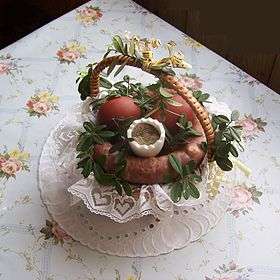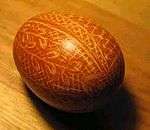Pisanka (Polish)
Polish pisanka (plural pisanki) or jaja wielkanocne[1] (Easter eggs); piski, kraszonki[2] is a common name for an egg (usually that of a chicken, although goose or duck eggs are also used) richly ornamented using various techniques. The word pisanka is derived from the verb 'pisać' which in contemporary Polish means exclusively 'to write' yet in old Polish meant also 'to paint'. Originating as a pagan tradition, pisanki were absorbed by Christianity to become the traditional Easter egg. Pisanki are now considered to symbolise the revival of nature and the hope that Christians gain from faith in the resurrection of Jesus Christ.
There are various types of pisanki, based on the technique and preparation used:
Kraszanki
Kraszanki (sometimes called malowanki or byczki) are made by boiling an egg in a decoction of plants or other natural products. The colour of kraszanka depends on the kind of product used:

Drapanki
Drapanki or skrobanki are made by scratching the surface of a kraszanka with a sharp tool to reveal the white of the egg shell.

Pacenka
Pacenka are created by drawing or painting. Traditional technique requires the egg shell to be covered with a layer of molten wax in which the pattern is scratched. The egg is then submerged into a dye. Finally, the wax preventing the dye to adhere to the eggshell is removed. Thus, the pattern is created in a manner similar to the sgraffito technique.
Naklejanki
Naklejanki or nalepianki are decorated with petals of elderberry, scraps of colourful paper (including wycinanki) or with patches of cloth. Popular in Łowicz and the surrounding area.
Oklejanki
Oklejanki or wyklejanki are decorated with bulrush pith or yarn. They are common in the Podlaskie region of Poland.
In the past, only women decorated eggs. Men were not allowed to come inside the house during the process, as it was believed that they could put a spell on the eggs, and cause bad luck.
Today in Poland, eggs and pisanki are hallowed on Easter Saturday along with the traditional Easter basket. On Easter Sunday, before the ceremonial breakfast, these eggs are exchanged and shared among the family at the table. This is a symbol of friendship, similar to the sharing of the Opłatek (Christmas wafer) on Christmas Eve.
References
- Święta polskie: tradycja i obyczaj 1996 p. 192
- Zwyczaje, obrzędy i tradycje w Polsce - 2001, s. 161